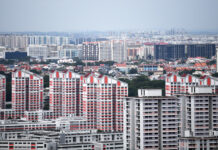SINGAPORE: Inevitable.
That was the word Health Minister Gan Kim Yong used on Jan 22 when describing the possibility of an imported case of the Wuhan coronavirus in Singapore.
Singapore is a global transport hub, he reasoned. And the situation in China is constantly evolving, with Thailand then Japan also announcing confirmed cases.
READ: Singapore confirms 3 new cases of Wuhan virus; total of 10 infected
It all started at the turn of the new year, when Wuhan in China’s central Hubei province announced the outbreak of a cluster of severe pneumonia. More than two weeks later, on the same day Mr Gan spoke to reporters, 17 people in China had died from the new virus, with more than 470 confirmed cases.
People are seen wearing a protective face mask at Orchard Road, Singapore on Jan 28. (Photo: Gaya Chandramohan)
Mr Gan also announced that he would jointly lead a multi-ministry task force to tackle the spread of the virus in Singapore. After SARS infected 238 and killed 33 people here in 2003, this was serious business.
Just a day later, the inevitable happened.
Singapore had its first case of the Wuhan virus.
HOLIDAY TO HOSPITAL
On Jan 20, a 66-year-old Wuhan resident flew with his family to Singapore from Guangzhou on a China Southern flight. The next day, he developed a fever and began coughing.
READ: Wuhan virus in Singapore: What can you do?
When he visited Singapore General Hospital on Jan 22, he was immediately isolated, diagnosed with pneumonia and identified as a suspect case at 10pm. The next evening, he tested positive for the new coronavirus.
A man seen wearing a protective face mask in Singapore on Jan 28. (Photo: Gaya Chandramohan)
Singapore had been gearing up for this moment.
Initially, authorities implemented temperature screening at Changi Airport only for travellers from Wuhan. This was soon extended to all travellers from China, with those found to have pneumonia and recent travel history to China isolated.
In China, authorities locked down Wuhan in an attempt to contain the fast-spreading virus. Scoot, the budget arm of Singapore Airlines, cancelled flights to the city.
Before the first case was announced, Prime Minister Lee Hsien Loong took time out of the annual economic meeting in Davos to give his first public comments on the situation. After the SARS episode, Singapore was better prepared to deal with another outbreak, he reassured.
Additional measures came swiftly. Singapore expanded temperature screening to land and sea checkpoints, as authorities braced for a high volume of travel during the Chinese New Year holiday.
READ: Wuhan virus in Singapore: What we know about the confirmed cases
SECOND AND THIRD CASES
In the early hours of Jan 24, Mr Lee in his yearly Chinese New Year message said Singaporeans should be calm but watchful. The Government was implementing measures to keep everybody safe and healthy, he added.
Later that afternoon, the Ministry of Health (MOH) announced two more confirmed cases of the virus: The 37-year-old son of the first case and a 53-year-old woman from Wuhan who arrived in Singapore via a Scoot flight on Jan 21.
According to MOH, the woman had visited Orchard Road, Marina Bay Sands and Gardens by the Bay, and used public transport like taxis and the MRT. But officials stressed that the risk of transient contact was low.
This did not stop Singaporeans from snapping up masks, thermometers and hand sanitisers at pharmacies islandwide, with reports of long queues and empty shelves. MOH, however, said the supply of masks was more than sufficient.
A note on the glass door of a Watsons store in Singapore on Jan 28 informs customers that masks are out of stock. (Photo: Gaya Chandramohan)
Back in Wuhan, anxious foreigners awaited evacuation. People were told to stay at home as public transport had been halted and the healthcare system was overwhelmed. On Jan 25, Singapore’s Ministry of Foreign Affairs said it was in touch with 35 Singaporeans in Wuhan, stating that they were well.
Also that day, Malaysia announced its first three cases of the Wuhan virus, all linked to Singapore’s first case.
FOURTH AND FIFTH CASES
On the evening of Jan 26, Singapore confirmed its fourth case: A 36-year-old Chinese man from Wuhan who arrived in Singapore with his family on Jan 22.
The next day, the task force announced to a packed press conference that it was ramping up measures to combat the outbreak. This included increased border checks and compulsory leave of absence for students, teachers, healthcare and eldercare workers returning from China.
READ: Wuhan virus outbreak – At a glance
People are seen wearing a protective face mask at Orchard Road, Singapore on Jan 28. (Photo: Gaya Chandramohan)
Furthermore, several university hostels, government-linked chalets and the Outward Bound camp on Pulau Ubin were being prepared as quarantine facilities, as authorities anticipated a potential spike in the number of people needing to be isolated.
Task force ministers took turns detailing the Government’s strategies, including how it plans to ease the potential impact on workers and the economy. They also revealed that officials were working with China to repatriate Singaporeans stuck in Wuhan.
National Development Minister Lawrence Wong, who co-leads the task force, said Singapore should be psychologically prepared that the Wuhan virus could be worse than SARS, although he said it was too early to tell how the two compared.
People are seen wearing a protective face mask at Orchard Road, Singapore on Jan 28. (Photo: Gaya Chandramohan)
Meanwhile, the World Health Organization updated its Wuhan virus risk level to “very high in China, high at the regional level and high at the global level”. It admitted that it had incorrectly stated in previous reports that the global risk was “moderate”.
MOH officials highlighted that the ministry was working with healthcare stakeholders to improve its virus testing capabilities, even as scientists around the world scrambled to find a vaccine.
Later that evening, Singapore confirmed its fifth case: A 56-year-old Chinese woman from Wuhan who arrived in Singapore with her family on Jan 18. This comes as the WHO said it was still probing if the virus could spread before symptoms emerged.
SIXTH AND SEVENTH CASES
On Jan 28, Singapore announced its sixth and seventh cases, both Chinese nationals from Wuhan: A 56-year-old and another 35-year-old man who arrived in Singapore on Jan 19 and Jan 23, respectively.
The Government had indicated that it was prepared to do more if necessary, with such efforts soon becoming apparent.
A person wearing a protective face mask at Orchard Road, Singapore on Jan 28. (File photo: Gaya Chandramohan)
At the same press briefing, authorities announced that Singapore would stop entry or transit for new visitors who have travelled to Hubei in the last 14 days, as well as holders of Chinese passports issued in Hubei.
The country would also suspend new visas being issued for holders of Chinese passports issued in Hubei, as well as previously issued short-term visas and multiple-visit visas. The measures follow similar restrictions in places like Malaysia, Mongolia, Hong Kong and Macau.
People are seen wearing a protective face mask at Orchard Road, Singapore on Jan 28. (Photo: Gaya Chandramohan)
Social media had been buzzing with discussions, questions and speculation about the virus.
Later that evening, the Protection from Online Falsehoods and Manipulation Act (POFMA) Office issued a targeted correction direction to Facebook over two posts claiming that Woodlands MRT station was closed due to the virus.
It was the second correction notice issued in relation to the Wuhan virus, following a HardwareZone Forum post claiming that a person in Singapore had died from the virus. Earlier, the Government had stressed the need for swift action against such falsehoods.
NO END IN SIGHT, BUT SOME GOOD NEWS
This is especially as the virus is expected to stick around for some time.
Experts warned that the outbreak could last months, as research emerged that the virus could have been present in China since Dec 1, a full month before Wuhan raised the alarm.
READ: PM Lee says Singapore ‘better prepared’ for another virus after SARS outbreak
A boy wearing a mask plays with a toy at Singapore General Hospital, Jan 28.
Global efforts to combat the virus also started to pick up momentum. On Jan 29, the United States announced that it was developing a vaccine for the deadly virus, although the process could take six months before moving to the next phase.
Scientists in Australia also said they had successfully developed a lab-grown version of the Wuhan coronavirus, the first to be recreated outside of China, in a breakthrough that could help combat the global spread of the illness.
The virus sample would be used to generate an antibody test, allowing detection of the virus in patients who had not shown symptoms, and create a vaccine.
Russia also revealed that it was working with China to develop a vaccine, stating that Beijing has handed over the virus genome to rapidly develop express-tests that can identify the virus in the human body within two hours.
EIGHTH, NINTH AND 10TH CASES
In the evening of Jan 29, Singapore confirmed its three latest cases, again all Chinese nationals who travelled from Wuhan.
The eighth and ninth cases are a married couple – a 56-year-old woman and 56-year-old man. They arrived in Singapore on Jan 19 and are currently isolated at the National Centre for Infectious Diseases (NCID).
The 10th case is a 56-year-old man who arrived in Singapore on Jan 20. He developed symptoms on Jan 21 and was admitted to NCID a week later, after being identified as a suspect case at a health screening station at Marina South Pier.
“This is consistent with our assessment that more imported cases are expected from Hubei province,” MOH said, reiterating that there is currently no evidence of community spread in Singapore.
WHAT NEXT?
With China reporting more cases and deaths as the days go by, and the virus continuing to spread to more countries, the global challenge to contain the virus is self-evident.
In Singapore, efforts to deal with the challenge have intensified, with more in the pipeline if necessary. Still, as Mr Lee pointed out in a Facebook post on Jan 26, people have to go about their work and lives, to make sure the country’s systems continue to run smoothly and things get done.
He said: “We must remain vigilant and take precautions to protect ourselves, but as the saying goes, Keep Calm and Carry On.”
MORE: Our coverage on the Wuhan virus and its developments
Subscribe to our Telegram channel for the latest updates on the Wuhan virus outbreak: https://cna.asia/telegram
Full coverage: https://cna.asia/wuhan-virus




